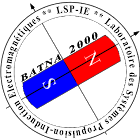, “New MRAS Approach for Sensorless control of IM,” 19th International Conference on Sciences and Techniques of Automatic Control and Computer Engineering (STA). pp. 36-40, 2019.Abstract
Équipe 01
, “New Synergetic Control for an Induction Motor with a synergetic Speed and Rotor Flux Estimation,” ICCEE’18 International conference on communications and electrical engineering. 2018.
, “Robust Dynamic surface control of interior Permanent Magnet Synchronous Motors,” international conference on Electronics, Energy and measurement (IC2EM). 2018.
, “Robust Backstepping control with integral action of IPM Synchronous Motor,” The Third international conference on Electrical sciences and technologies in Maghreb (CISTEM). 2018.
, “dSPACE Validation of Improved Backstepping Optimal Energy Control for Photovoltaic Systems,” 6th International Renewable and Sustainable Energy Conference (IRSEC). pp. 1-6, 2018.Abstract
, “BLEVE fireball modeling using Fire Dynamics Simulator (FDS) in an Algerian gas industry,” Journal of Loss Prevention in the Process Industries, vol. 54, pp. 69-84, 2018.Abstract
, “Quantitative consequence analysis using Sedov-Taylor blast wave model. Part II: Case study in an Algerian gas industry,” Process Safety and Environmental Protection, DOI: 10.1016/j.psep.2018.02.003., 2018.
, “Quantitative consequence analysis using Sedov-Taylor blast wave model. Part I: Model description and validation,” Process Safety and Environmental Protection, DOI: 10.1016/j.psep.2018.02.002., no. 10.1016, pp. 116, 2018.
, “Integral Backstepping Control of PMSM for Electrical Vehicle ApplicationOctober,” International Conference on Electrical Engineering -ICEE’2017. 2017.
, “New Sensorless Speed Control of IPMSM Based on Backstepping Observer,” J. Automation & Systems Engineering , vol. 11 N°3, pp. 230-243, 2017.
, “Optimal Energy Control of Induction Motor Standalone Photovoltaic-Battery Pumping System,” 6th International Conference on Systems and Control. 2017.
, “Robust Backstepping MPPT for Photovoltaic System,” International Journal of Control Theory and Applications, vol. 9 (38), pp. 179-188, 2017.
, “Modified speed sensorless indirect field-oriented of induction motor drive,” International Journal of Modelling, Identification and Control journal, vol. 21 No. 4, pp. 370-377, 2016.
, “Robust Backstepping MPPT for Photovoltaic System,” 3rd International conference on green energy & Environmental engineering GEEE’2016. 2016.
, “Robust Backstepping MPPT for Photovoltaic System,” International Journal of Chem Tech Research :IJCRGG, 2016.
